
|
|

|
Hokusai - Ehon Sumida Gawa - Prints 2-3 and 2-4

|
|

|
On March 2, 1657, the great Meireki fire killed about 100,000 people living in the city of Edo. Muenji temple (無縁寺, which translates into “without relatives temple”), also known as Ekō-in (回向院), was built to commemorate all the victims of the fire, most of whom were not survived by relatives. The protruding blue roof of Muenji temple can be clearly discerned in the middle of print 2-4 (click to enlarge).
The site of Muenji temple later became also very well-known for its sumo wrestling contests. From 1768 onwards these contests were held in the square constructions visible in front of Muenji temple in print 2-4 with the aim of raising money for the temple. The start of these sumo matches was announced by the loud beating of a huge drum mounted on top of a tall tower ouside the main hall of Muenji temple. The tower was 16 meters high, and constructed of enormous cedar logs. The reason it was so high was that the surface of the Sumida river could reflect the sound of the drum, allowing its echoes to be heard all over the city.
During sumo tournaments the drum was played on two occasions every day: early in the morning to gather people, and at the end of each day’s matches to request the audience to come back again the next day (except for the last day of the fifteen-day tournament). Both the tower and the drum are immortalised in Hiroshige’s Ekō-in temple and Moto Yanagi bridge print from the series “One hundred famous views of Edo”, see prints 1-11 and 1-12.
In the evening, as darkness fell over the river, the sky was lit up by multicolored fireworks. Fireworks festivals were held several times a year in Ryōgoku, usually - but not always - to coincide with the sumo tournaments. The bakufu often payed part of the cost for these festivals, in order to provide entertainment to the citizens of Edo. The owners of restaurants along the Sumida river and of yakatabune (see below), however, would often also join forces in the organisation and funding of fireworks at Ryōgoku bridge in order to attract customers and boost business.
The array of black stakes in the water near the east bank visible in print 2-4 were known as the Hyappongui (百本抗, meaning “Hundred stakes”). They were designed as a breakwater to protect the east shore of the Sumida river from the quickened current as the river curved eastward.
Several types of boats are seen sailing up and down the Sumida river in these two prints. The largest ones are yakatabune (屋形船, literally meaning “house boat”). These are large pleasure boats, or “floating restaurants” that conduct tours on the river. These boats with roofed cabins were usually large enough for ten to twenty people. Wealthy merchants or samurai would hire them for an entire day, and take their family or some guests on a party cruise. Inside the cabin there were tables where guests could eat and drink while they watched the river scenery. The more expensive yakatabune even had geisha working on them, to serve the customers food and sake. The yakatabune specialized in long, leisurely cruises up and down the river.
A much smaller type of boat displayed in print 2-3 is a yanebune (屋根船, which translates into “roof boat”). The green blinds from the roof of these boats could be lowered, thus not only protecting passengers from bad weather conditions but also hiding from view what was happening inside. The later Tempō reforms of 1842 would - temporarily - forbid the lowering of the green blinds of yanebune except for rain, snow, and wind.
In print 2-4 we see one takasebune (高瀬舟, which literally translates into a “shallow river boat”). These were originally designed for the Takase river, a shallow river in Kyoto, but later were used all over Japan. They were flatboats used to transport cargo. They had a very shallow draft, which allowed them to carry their cargo far up-river. The takasebune also had sails, which could be used whenever the river was broad enough and the wind strong enough to make oars unnecessary. These ships could not only transport cargo from shore to shore; they could also carry the goods downriver into Edo bay and along the coast to other ports.
Prints 2-3 and 2-4 also contain quite a number of chokibune (猪牙舟, which literally means “boar tusk boat”, referring to the shape of their bow). These were long, thin, roofless fast-sailing small boats, used as river taxis for one or two passengers, and functionally quite similar to the current-day gondolas in Venice.
We finally also see urourobune (うろうろ舟, i.e., “casual wandering boats”) that sailed from one yakatabune to another selling drinks and food.
Here are two other prints dedicated to Ryōgoku bridge. They were designed by Utagawa Hiroshige for the “One hundred famous views of Edo series” series published in 1857 (click to enlarge):
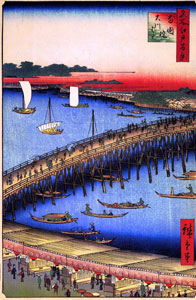
|

|
| Ryōgoku bridge and the great riverbank |
Fireworks at Ryōgoku |
The view on the left is from the south west looking out to the north east, displaying Okura bridge on the upper left. The view on the right is from the north west looking out to the south east. By taking a close look at the east bank in the enlargement of this print you will recognise the shōgun’s boat sheds in prints 1-13 and 1-14 and 1-15 and 1-16.
In 1932 the original Ryōgoku bridge of 1659 was replaced by this bridge (click to enlarge), a picture I made while visiting Tokyo in 2017:

|
Ryōgoku bridge today |
These are photos I took of Ekō-in temple in 2017 as well as the stamps and calligraphy I obtained from a priest at the Ekō-in temple in my goshuinchō temple stamp book (click to enlarge):
.jpg)
|
.jpg)
|
.jpg)
|
| Sign-post to Ekō-in temple | Torii gate to Ekō-in temple | Ekō-in temple proper |
.jpg)
|
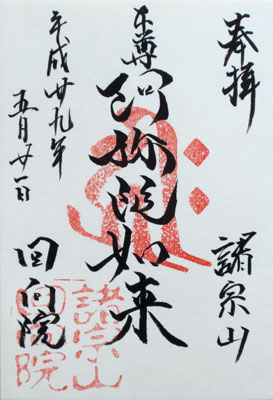
|
.jpg)
|
| The graveyard of Ekō-in temple | Ekō-in temple goshuinchō stamps and calligraphy | Buddha statue in the graveyard of Ekō-in temple |
The yellow kanji on the top of the torii gate are (from right to left) 回向院: Ekō-in temple. The kanji in the calligraphy in the two top left columns of my goshuinchō book page are 平成二十九年五月二十一日. This translates into Heisei 29, the 5th month, the 21th day, and thus in 2017, May 21: the date of my visit to the temple.
In Edo times the sumo wrestling contests were held outside in the open air in constructions without roofs but nowadays they are performed in the Ryōgoku Kokugikan (両国国技館, which literally translates into “Ryōgoku Country skill Hall”) indoor sporting arena opened in 1985. It is located on the eastbank of the Sumida river just a few minutes walk away from Ryōgoku bridge. These are photos I took of the Ryōgoku Kokugikan sumo Hall in 2017 (click to enlarge):
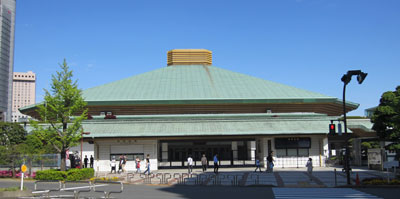
|
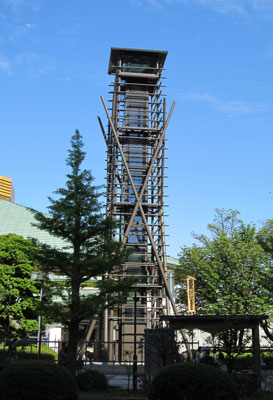
|
| The Ryōgoku Kokugikan sumo Hall | The tower at Ryōgoku Kokugikan sumo Hall |
Today drums are still being played on the top of the tower in my picture on the right before and at the end of the tournaments.
Nowadays, modern yakatabune can also still be hired for cruises up and down the Sumida river:
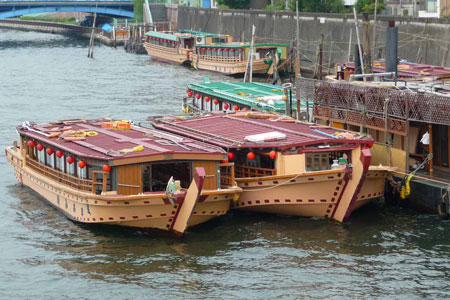
|
Yakatabune today |